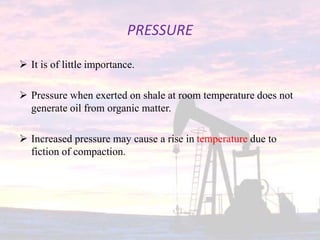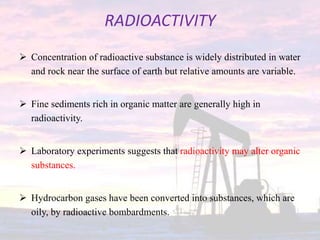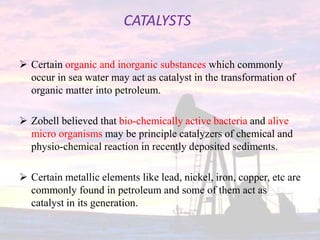oil.pptx
- 1. ORIGIN OF OIL Submitted by, Kavya Mol K S Dept. of Geology
- 2. ORIGIN OF OIL Theories about the origin of oil are; Raw materials consists of simple marine organisms, which lives in warm shallow seas. Organic matter should accumulate at the bottom- where seawater is stagnant and deficient in oxygen; substance is neither destroyed by oxidation nor eaten away by other animals. The bacteria that thrive in the upper mud of the sea floor are considered to change the organic matter into mother material of oil by removing oxygen and nitrogen and bringing about other changes.
- 3. With the deep burial of sediment material, the bacterial action ceases and provides pressure and heat coverting the substances into droplets of liquid oil and tiny bubbles of gas. Gradual compaction of the enclosed sediments under the pressure of the increase in weight reduces the space with in the rock particles, and squeezes out the oil, gas, and water into nearby layers of the sand / sandstone where open spaces are larger. The oil not remain in the source rock in which it orginates. To give rise to a rock rich in petroleum deposits there should be a source rock, from petroleum is derived, a porous formation to transmit it and a cap rock to hold it in a proper geologic structure.
- 4. Schematic diagram of oil generation.
- 5. SOURCE BEDS Sedimentary deposits from which petroleum or natural gas has been generated. Trask noted a definite relationship between organic content of sediments and the texture. Organic matter are usually preserved in fine grained sediments because they are usually deposited in quite water, which contain less oxygen than agitated water. He estimated that at least 90% of the organic material is destroyed before it is deposited. After deposition it tend to decrease in quantity with the passage of time.
- 6. Small percentage of organic matter, which is deposited is further reduced in amount by bacterial action. Bacteria do not destroy much organic matter after it is buried. Zobell studied the abundance of bacterial population in cores of recent sediments up to 75 cm in length. He noted a sharp decrease in the number of bacteria with core depth and concludes that, the greatest bacterial activity is with in the top most few mm of the sediments. Trask esimated that by the time the sediments have been buried up to depth of 30 cm, the quantity of organic matter seems to have reduced about 15%. Then, lithification take place over a period of time.
- 7. Average decrease in organic content will be about 40%. He believed that anerobic bacteria are the only living thing which can alter, organic matter in sediments after it has been buried to considerable depth. Favourable source bed are fine textured shales and limestones. Drilling in source rock rarely produces petroleum. The porosity of the rock is lowered from 90 to 35 %, when the source rock is compacted into a rock, so large quantities of water is squeezed out from it. The water, oil and gas had the power of movement and travel through it, until an impervious rock structure stop them.
- 8. TRANSFORMATION OF ORGANIC MATTER TO PETROLEUM Bio-chemical changes Geo- chemical changes
- 9. BIO-CHEMICAL CHANGES The reduction of nitrogen, oxygen, hydrogen, sulphur, phosphorous content of organic matter occur when the petroleum is formed from plant and animal matter. Zobell and others state that bacteria reduce those substance in the recent marine sediments. Its upper most layer has a large population of bio-chemically active bacteria. Many thousands of them have been recovered from recent sediments to a depth of more than 20ft below sea level. Anerobic bacteria act on plant and animal matter and produces substances like petroleum by splitting oxygen, nitrogen, sulphur and phosphorous from the organic compound and the end product will consist of carbon and hydrogen.
- 10. GEO-CHEMICAL CHANGES Chemical reaction occurs after the sediments are buried to a considerable depth. Factors that influenced the reaction include heat, pressure, earth movements, geologic time and possibly other known factors.
- 11. TEMPERATURE Geological and chemical evidences suggest that the petroleum has had a low temperature history. There are no carbonaceous residues or other evidences of heat decomposition in beds associated with petroleum deposits. Barton believes that much of the crude oil of the Gulf coast could not have been subjected to temperature much higher than 50°C. He is of the opinon that the chemical composition of the mother source material was about same for all oil and the present character depends upon the transformation of oil progressively with time i.e., from naphthenic to parafinic oil.
- 12. PRESSURE It is of little importance. Pressure when exerted on shale at room temperature does not generate oil from organic matter. Increased pressure may cause a rise in temperature due to fiction of compaction.
- 13. RADIOACTIVITY Concentration of radioactive substance is widely distributed in water and rock near the surface of earth but relative amounts are variable. Fine sediments rich in organic matter are generally high in radioactivity. Laboratory experiments suggests that radioactivity may alter organic substances. Hydrocarbon gases have been converted into substances, which are oily, by radioactive bombardments.
- 14. CATALYSTS Certain organic and inorganic substances which commonly occur in sea water may act as catalyst in the transformation of organic matter into petroleum. Zobell believed that bio-chemically active bacteria and alive micro organisms may be principle catalyzers of chemical and physio-chemical reaction in recently deposited sediments. Certain metallic elements like lead, nickel, iron, copper, etc are commonly found in petroleum and some of them act as catalyst in its generation.
- 15. CONCLUSION Oil is originated from the sorce rock, from where it is migrated and get accumulated in the reservoir rock and finally it is trapped by a cap rock. For the transformation of organic matter to petroleum two changes occur; bio-chemical changes and geo-chemical changes. Bacteria plays a major role in bio-chemical changes. Geo-chemical changes are influenced by temperature, pressure,radioactivity, catalysts etc.















